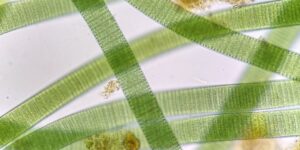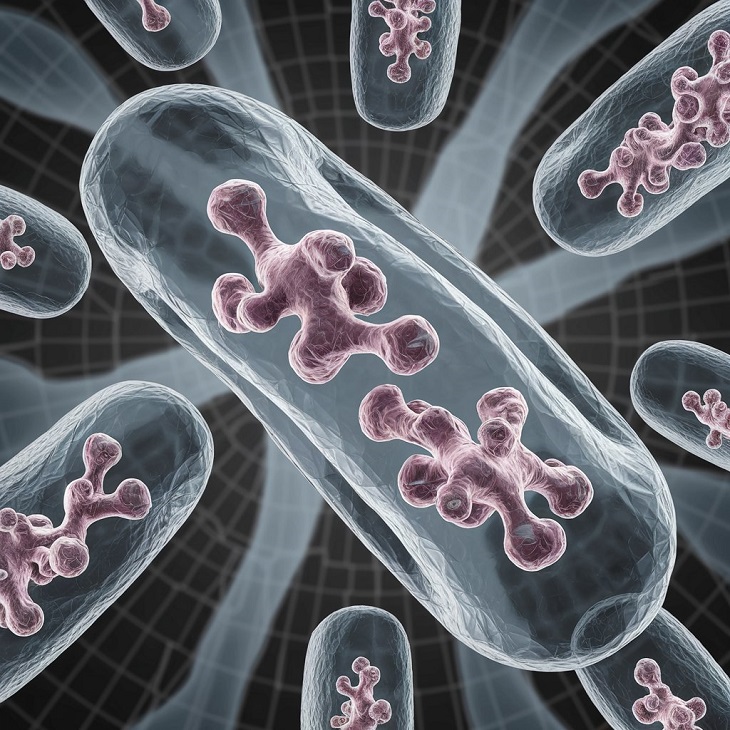This kingdom includes the simplest and most primitive life forms. While they are diverse, they share common cellular characteristics: unicellular and prokaryotic (lacking a nucleus or internal organelles). They reproduce asexually, with nutrition types varying between autotrophic and heterotrophic, depending on the species.
The organisms grouped in the kingdom Monera are very primitive. It is believed that they were the first life forms to inhabit the Earth .
One of the most accepted ideas is the so-called Theory of serial endosymbiosis , developed by the American biologist Lynn Margulis in 1967. This theory proposes that a pair of unicellular organisms belonging to the kingdom monera would have developed a very close symbiosis, which led one to form part of the other’s body and take care of some internal functions.
Characteristics of the Monera kingdom
The main characteristics shared by the members of the Monera kingdom are:
- They are very small in size . They are the smallest living beings that exist on the planet. They measure from 3 to 5 micrometers (thousandths of a millimeter).
- They are unicellular . They are organisms formed by a single cell, which functions autonomously. They do not form tissues or more complex organs.
- They are prokaryotes . They are very simple cells: they lack a cell nucleus and do not have organelles of any kind. The genetic information is found in a circular DNA molecule that is loose in the cytoplasm .
- They reproduce asexually . They are organisms that reproduce by binary fission , a reproduction mechanism that does not involve the production of sex cells. In this process, one individual gives rise to two that are identical.
- They can have heterotrophic or autotrophic nutrition . Many species within this kingdom are heterotrophic organisms (they feed on organic matter from the environment ). Other species are autotrophic (they make their own food). They obtain organic matter by taking advantage of sunlight and other substances (photosynthesis) or through chemical reactions from the environment (chemosynthesis).
Organisms traditionally grouped into the kingdom Monera included all prokaryotes, i.e. bacteria and archaea . Over time, major differences were discovered between these two groups, leading to them being considered distinct life forms.
History of the Monera Kingdom
The term “monera” has its roots in the Greek word moneres (meaning “simple”) and has been used over time with different meanings. It was first proposed by the German naturalist and philosopher Ernst Haeckel in 1866, who proposed a classification of life based on evolutionism.
Haeckel distinguished three kingdoms: animal, vegetal and Protista, and grouped into the latter all the “simple” or “primitive” life forms that did not seem to have a specific relationship with animals and plants , considered “higher”. Haeckel placed the microscopic monera at the base of the evolutionary tree and classified them within the Protista kingdom.
Later, in the 1920s, the French naturalist Édouard Pierre Chatton discovered that bacteria do not have a cell nucleus and, based on this finding, proposed the distinction and use of the terms prokaryotes for organisms without a cell nucleus and eukaryotes for organisms with a cell nucleus respectively.

(which included prokaryotes). In 1969, the American ecologist Robert Whittaker added the kingdom of fungi (Fungi) to this classification.
Classification of the Monera kingdom
The main groups within the kingdom Monera are:
1. Eubacteria
The name eubacteriss means “true bacteria” and they represent the simplest forms of cellular life known on Earth . This group of prokaryotic organisms has a single chromosome and a rigid cell wall composed of peptidoglycan (a combination of sugars and amino acids that gives great strength).
Some bacteria are mobile and have flagella that they use to move. They can have different shapes and can be classified according to this criterion as bacilli (rod-shaped), cocci (round-shaped), spirilla (cork-shaped) and vibrios (comma-shaped).
2. Archaebacteria
Archaebacteria share some characteristics with bacteria (such as the lack of a nucleus within the cell), but their differences, such as the composition of their cell wall, place them in a category of their own.
They are characterized by living in conditions that make the life of other living beings impossible . They are found in extreme habitats , where they survive by taking advantage of the chemical resources of the environment (such as salinity, heat , pH ). It is believed that they are so numerous that they make up 20% of the terrestrial biomass.
3. Cyanobacteria
Known as blue-green algae , cyanobacteria are the only prokaryotic organisms capable of performing oxygenic photosynthesis , like plants (although in a slightly different way).
They are the largest prokaryotes: they can reach dimensions of up to 60 micrometers. Their presence in most habitats allows them to form symbiotic relationships with other species .
Differences between bacteria and archaea
The difference between bacteria and archaea is that they have different evolutionary origins . Despite morphological similarities, molecular studies have revealed that archaea are actually much older and are not evolutionarily related to bacteria. For this reason, there are scientific proposals to consider that bacteria and archaea do not belong to the same kingdom.
Taxonomy of the kingdom Monera
This kingdom was initially subdivided into two: bacteria and archaea, each with its own sub classification. But after the discovery of ribosomal DNA in the 1980s, a new classification based on four distinct groups could be established:
- Mendosicutes , archaea or archaebacteria . Archaea means “ancient” because they were initially thought to be a kind of protobacteria. They are difficult to classify because they are actually very small, but they have metabolic pathways and internal processes that are much more similar to eukaryotes than to other traditional prokaryotes.
- Mollicutes , Tenericutes or mycoplasmas are a type of bacteria that are mostly parasitic, whose notable feature is that they lack the cell wall present in most bacteria and that they have one of the simplest shapes and genetic codes known.
- Gracilicutes or Gram-negative bacteria are a supergroup of bacteria that includes the groups Spirochaetes , Proteobacteria , Planctobacteria and Sphingobacteria . They are characterized by having a very thin cell wall (sometimes even absent) composed of murein and a double plasma membrane . The characteristics of their cell wall make them not susceptible to Gram staining, hence their name.
- Firmicutes or gram-positive bacteria . Called endobacteria, they have a very thick cell wall and are shaped like a rod or coccus. This group includes gram-positive bacteria, which respond to Gram stain by turning blue or violet.
Examples from the Monera kingdom

Some examples of organisms of the Monera kingdom are:
- Escherichia coli is a gram-negative bacillus that often lives in the human digestive tract.
- Clostridium tetani is a very common bacterium in soil and in the digestive tract of some animals, which can cause a disease known as tetanus.
- Helicobacter pylori is a bacterium that can infect stomach cells in some mammals and cause ulcers .
- Bacillus anthracis is a bacterium that lives in the digestive tract of some herbivores and forms spores. It can affect human health.
- Mycobacterium tuberculosis is the causative agent of tuberculosis in humans. It is an intracellular pathogen, since it can live inside eukaryotic cells. Its cultivation is very difficult and slow .
- Treponema pallidum . It is an elongated, spiral-shaped bacterium. It is responsible for syphilis, a disease that only exists in humans .
- Anabaena variables is a cyanobacterium . It has the ability to photosynthesize and form symbiosis with plants and fungi.
- Methanococcus jannaschii is an archaea. It lives in environments with extreme temperatures (it is thermophilic) and eliminates methane as a waste product of its metabolism .
- Halobacterium salinarum is an archaea. It lives in environments with high salt concentrations (it is a halophyte).
- Thermoproteus ten ax . It is an archaea. It lives in environments with extreme temperatures (it is thermophilic). It uses sulfur in its metabolism.
Importance of the Monera kingdom
Members of the Monera kingdom were the first organisms to exist when life originated on the planet . Their simplicity allowed them to emerge and survive in the hostile initial conditions of the Earth and even today it is possible to find representatives of this group in habitats where other forms of life cannot adapt or survive.
From this perspective, studying these organisms means trying to deepen our knowledge about the origin of life.
Within this group, many are infectious agents of humans , the study of which allows us to better combat diseases and save lives. On the other hand, many microorganisms classified in this kingdom are used by humans in different industries, such as the pharmaceutical or food industries .
The Monera kingdom is fundamental to the environment , especially for its role in food webs . Many bacteria are decomposers and, therefore, allow the carbon cycle to be completed , and this element to be returned to its inorganic form. Nitrogen-fixing bacteria, for example, are of great importance to plants.
FOR FERDUR INFORMATION:https://techlicss.com/

